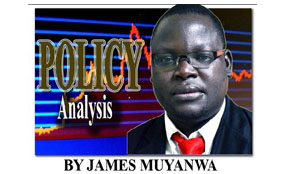 OUR dear Kwacha has received a lot of bashing in the last few months and this week posted its record-low exchange rate against the United States dollar.
OUR dear Kwacha has received a lot of bashing in the last few months and this week posted its record-low exchange rate against the United States dollar.
On Monday it hit a record-low of K6.10 to the dollar, extending recent losses, which Bank of Zambia (BoZ) blames on falling copper prices on the international market and foreign investor fears at the prospect of monetary tightening by the US Federal Reserve.
According to the BoZ, in 2013, the Kwacha depreciated by 4.9 per cent against the dollar, 3.6 per cent against the British Pound, and by 8.3 per cent against the Euro but appreciated by 10.7 per cent against the South African Rand.
The average kwacha/dollar volatility declined from K0.53 in 2012 to K0.34 in 2013.
Since January 2014, however, the Kwacha has been performing badly against major convertible currencies and crossed the K6-per-dollar mark in the first week of March.
It hit the record-low of K6.10 to the dollar on Monday.
The fall of the Kwacha exchange rate has been caused by both international and local factors.
According to the Central Bank the recent happenings in the sector reflect the responses to the country’s growth needs and changes in the international environment.
Increased demand for imports of capital goods has contributed to the demand of the dollar and other major currencies thereby leading to the lowering of the value for the local currency.
Globally, the currency for Zambia, which is among the leading copper producers, has been adversely affected by the prices of copper on the London Metal Exchange and other platforms.
Zambia has had to contend with falling prices which sagged to almost four-year lows last week as worries about China’s economic slowdown intensified.
Indeed, internationally, the US Federal Reserve Board’s decision to reduce the amount of US dollar liquidity has broadly had effects on emerging markets like Zambia.
For copper, the prices dropped from an average of about $7,010 per tonne at the end of February 2014 to about $7,360 per tonne in December 2013.
Generally – despite the rise in the export figures – the import’s seems to have been outstripping them leading to the depreciation of the Kwacha in the near long-term period.
For this particular factor the solution will be, like the Economics Association of Zambia proposes, a two-fold one.
Firstly there is need to reduce the excessive dependence on imports and, secondly, there is need to increase the country’s figures for the non-traditional exports (NTEs).
I agree with EAZ president Isaac Ngoma that the two should be buttressed by the boost in the productivity in the country to make local products competitive when it comes to pricing.
The BoZ concedes that more recently there has been a slowdown in portfolio investment inflows which until now have played a critical role in financing the current account deficit.
The reduction in the portfolio investment inflows has resulted in further pressure on the Kwacha.
The question the experts at BoZ and other think tankers should be tackling is why the reduction in such inflows and what is the cure?
Another factor the Central Bank attributes the current situation to, is that there has been generally market sentiments indicating that the demand for the foreign exchange has remained high while the supply has been unusually low.
Again, we all need to know why!
What the BoZ does not state is that the Government borrowing has a bearing on what is happening, what with the widened national budget deficit for 2013.
Last year fiscal shortfall of 8.5 per cent of the Gross Domestic Product (GDP) significantly exceeded the projected figure of 4.3 per cent and obviously the Government had to resort to borrowing including externally, to help offset that.
“The large budget deficit, financed by borrowing from the banking system and planned external borrowing, is also fuelling high domestic and import demand, and probably contributing in this way to the depreciation,” says Mr Ngoma.
If increased borrowing by the Government is a contributory factor to the current depreciation of the Kwacha, then cutting on excessive borrowing is part of the solution to the bigger picture.
That can only be possible – like Mr Ngoma says – “by coming up with some revenue measures, but the main burden should lie with cutting Government expenditure.”
Yes, the Government should undertake an expenditure review, aimed at eliminating waste and uneconomic projects.
Other than in offloading $178 million of the international reserves the focus should be on increasing productivity, cutting down on the excessive dependence on imports and boosting the country’s NTEs.
Comments:
0955431442, 0977246099, 0964742506 or e-mail: jmuyanwa@gmail.com






